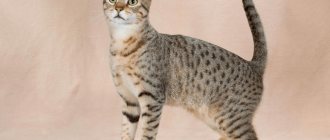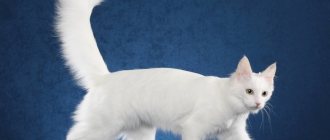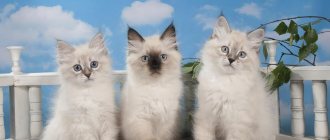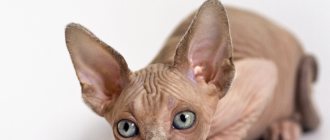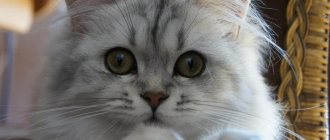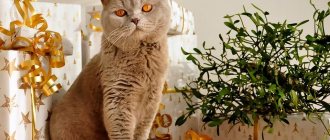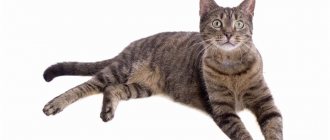The Highlander is an American experimental cat breed that was developed by crossing the Desert Lynx and the Jungle Curl. Distinctive features of the Highlander: a short tail, curled ears and a tabby pattern. By nature, this is an ordinary domestic cat, somewhat independent, affectionate and playful. Other names for the breed: Highlander shorthair or Highland Lynx.
Brief history of the breed
Work on breeding Highlanders began in 1993, when breeders decided to improve the already existing Desert Lynx cat variety. To make their ears curled, experts used representatives of the new hybrid breed Jungle Curl (obtained by crossing Bengals, Serengeti, Egyptian Mau, American Curls, Chausie, etc.).
As a result, the breeders managed to fix the folded ears while maintaining the spotted lynx coloring. In May 2008, the Highlander cat breed received recognition from TICA, and from 2021 it can be exhibited in the Advanced new breed class.
Read more - “About different breeds of cats with curled ears.”
Interesting Facts
Although the Highlanders do not have a rich history, many interesting things have been associated with them:
- The name of the breed Highland Lynx translates as “mountain lynx”. And in some sources these cats are referred to as shorthaired Highlanders.
- Due to the similar name, representatives of the breed are often confused with Highland Folds. But they are in no way related to the British and Scottish Longhairs.
- Formally, Highland Links can be considered hybrids. But the percentage of wild blood present in them is so small that it does not affect anything at all. Therefore, genetically, Highlanders are completely domestic cats that do not pose a threat to people.
History and breed standard
The breed was developed only 10 years ago. American breeders were faced with the task of creating a cat that looked like a wild lynx. The breed was taken as the “mountain lynx” (Highland Lynx). In fact, it has nothing to do with wild animals, just as it does not have wild genes in its genus.
I must say that the experiment was a great success. The result was a small domestic lynx, but absolutely domestic, affectionate and completely non-aggressive.
The breed received its own name in 2004. In the same year it was officially recognized and received its standard. Since 2008 he has been successfully participating in exhibitions.
Breed description, standards, appearance
Highlanders are muscular, compact cats with short tails and ears turned outward. Outwardly, they resemble strong and agile lynxes.
Dimensions and weight
Highlanders are fairly large cats with pronounced sexual dimorphism. The average weight of a female is 4.5-6.5 kg. The weight of a male Highland Lynx varies between 6.5-9 kg.
Anatomical characteristics
A typical Highlander cat should fit the following description:
- The head is triangular, with rounded cheekbones, a convex skull, a high forehead, a short blunt muzzle, pronounced whisker pads and a wide nose.
- The eyes are almond-shaped, medium-sized, slanting, widely set. The iris of the Highland Lynx can be green, orange or yellow.
- The ears are medium in size, with a wide base and flexible, curved back tips.
- The body is rectangular in shape, with a straight back, slightly raised croup and well-developed muscles.
- The limbs are of medium length, with rounded paws and pronounced knuckles.
- The tail is thick and short. Its length in Highland Links should not be less than 2.5 cm and longer than the hock joints.
On a note. The Highlander is one of the few breeds in which polydactyly is acceptable.
Color and coat type
The body of the Highland Lynx is covered with beautiful fur, the texture of which depends on the length and color. A cat of this breed is:
- shorthair - with a thick coat and dense undercoat;
- long-haired - with developed decorative hair, which, as it were, forms trousers and a frill.
According to the Highland Lynx breed standard, spotted, marbled or striped tabbies in any color combination are allowed.
On a note. The color of the Highlander's coat is determined by the tone of the undercoat. For example, if a cat's fur appears to be silver-black and her underpads are brown, then her color would be considered brown.
Possible breed defects
Exterior defects, the presence of which reduces the breeding value of the Highland Links:
- weak bones;
- the tail is shorter than 2.5 cm and longer than the hocks;
- ears are bent more than 90 degrees.
Buying a Highlander kitten
The breed is already quite popular in America; finding a nursery and a kitten available for sale is not difficult. The breed is little known outside the States. In Europe there is a large nursery in France and several breeders in other countries. There is no data on breeders in Russia. Making it even more difficult to find kittens is the fact that Scottish Longhaired Highland Fold cats are often mistakenly called Highlands.
Highlander cats are registered with TICA. If a kitten and its parents do not have documents from this organization, then they are not representatives of the breed, even if they have all the necessary external signs.
Those who are thinking about buying a Highland Lynx kitten abroad should take into account that since January 2013, crossing with other breeds is prohibited, with the exception of cats that are listed in the REFR (Rare and exotic feline registry) studbook or other registry. This organization considers the Highlander to be part of the Desert Lynx or Desert Lynx breed group, along with the Alpine Lynx and Mojave Bobs. One litter can produce kittens with different appearances. They are registered as follows:
- White kitten with straight or curled ears, straight hair - Alpin Lynx;
- All white kittens with curly hair are registered as Mojave Bobs:
- Non-white kittens with straight hair and straight ears are Desert Links;
- Non-white kittens with straight hair and curled ears are registered as Highlanders.
In turn, Desert Links do not recognize such interference in their breed and believe that the straight-eared Highlander is a hybrid and cannot bear the name of an already formed breed, even a new one.
Price
The price of a Highlander kitten (Highland Lynx) in American nurseries usually ranges from $800-1000. In this case we are talking about cats and cats not for breeding. The cost of promising babies can reach up to $3,000.
Character and temperament
The Highlander is a cat with a friendly and gentle disposition. He likes to be the center of everyone's attention, and he achieves this through funny pranks.
The curious Highland Lynx explores new places with the enthusiasm of a true explorer, but does not go on a “race” through curtains and closets.
On a note. Highlanders are not particularly talkative. To express emotions, representatives of the breed prefer to use tail wagging or an ingratiating look into the eyes of their owners.
The friendly nature of Highlanders allows them to easily find a common language with children. Non-jealous and calm cats never respond with aggression to childish pranks. Highland Links also easily get along with other pets and get along peacefully with all animals, including rodents, reptiles and birds.
Character
An adult Highlander is a cat with a sense of self-esteem. These are friendly pets who love their family but remain independent. They remain quietly alone. They don’t impose themselves when they see that people have no time for them. They do not have the habit of yelling out of boredom, marking or tearing up furniture to attract attention.
But still, the Highlander cat is more domestic than a yard cat. She needs contact with her family, active games, affection. The need for exercise is average after 3-5 years, but young Highlanders are playful, curious and active. This is not a sofa decoration - the cat will take part in the life of the family.
They love neat children and easily get along with harmless dogs. They are loyal to guests, but more often without much interest. Like Siberians or bobtails, Highlanders divide people into friends and foes. The hunting instinct is well expressed - you cannot leave them alone with birds, mice and other small animals.
The breed is not suitable for those who believe that a cat should obey. Your pet will easily learn the rules if you present them in a playful way with encouragement. To be forced to do anything involves a natural tendency to resist any restrictions, and this will quickly spoil a good-natured character.
How to choose the right kitten
The Highlander is an expensive and rare breed of cat. Leading breeders specializing in breeding such animals live in the United States. Therefore, you will most likely have to choose a Highland Lynx kitten in absentia. In this case, it is advisable to focus on the following criteria:
- availability of pedigree and veterinary passport;
- conditions of detention;
- behavioral characteristics;
- compliance with the breed standard;
- health status.
On a note. Highlander kittens are born straight-eared. As they grow, the tips of their ears curl back.
Care and maintenance
Unpretentious Highland Links are able to quickly adapt to any conditions. They live in apartments and private houses without any problems. Caring for Highlanders includes a number of standard procedures:
- The eyes and ears of cats are regularly examined for the presence of nonspecific discharge and wiped with cotton pads soaked in alcohol-free products.
- Highlanders' claws grow very quickly and break off. Therefore, they are systematically shortened with a nail cutter so as not to affect the blood vessels. And to prevent cats from tearing wallpaper and upholstered furniture, they are provided with scratching posts.
- Highlanders' teeth are brushed several times a week with a non-foaming paste using a special silicone brush or soft brush.
- Cats of this breed are bathed 3-4 times a year or as needed. Bath procedures are carried out in warm rooms where there are no drafts. And for washing they use special shampoos.
- Long-haired Highland Links require careful grooming. They are systematically combed out with a slicker brush or a brush with soft bristles. The hair of shorthaired Highlanders is treated several times a week with a special glove.
Health and disease of British Longhair cats
Longhaired British cats live up to 18-20 years. They have few health problems, but given the developing status of the breed, it is logical to assume that some of the ailments may manifest themselves over time. In the meantime, diseases such as hypertrophic cardiomyopathy and polycystic kidney disease cause discomfort to cats. As for obesity, to which diligently fed individuals are prone, it is easier to combat it in the early stages. Neglected fat cats manage to accumulate a sufficient number of serious ailments, including arthritis, diabetes and hepatic lipidosis.
Feeding the cat
Highlanders are active cats with an excellent appetite. They happily eat both industrial and natural food. Therefore, when choosing a diet, you can be guided by your own preferences.
With an industrial type of nutrition, Highland Links buy premium or super-premium food with a complete, well-balanced composition. The following brands of drying are perfect for cats of this breed:
- Acana;
- Bosch;
- Brit Care;
- Pronature.
Important! Highlanders, whose diet is based on dry food, should have free access to fresh drinking water.
With a natural type of nutrition, the menu of cats of this breed should be dominated by protein foods in the form of raw chicken, turkey, lean beef or rabbit meat. Several times a week, meat can be replaced with boiled offal and ocean fish. It is also recommended to include porridge, quail eggs, fermented milk products and vegetables in the diet of Highland Links.
To maintain normal functioning of the gastrointestinal tract, fatty meat, river fish, bones, potatoes, milk, sausages, pickles, confectionery and any food from the owner's table are excluded from the menu of these cats.
On a note. With a natural diet, mineral supplements are introduced into the Highlanders’ diet twice a year, which are selected after consultation with a veterinarian.
Education and physical activity
Highland Lynx cats are energetic and temperamental cats. To maintain muscle tone and good physical shape, they need a lot of exercise. If desired, Highlanders can be easily trained to walk on a harness. If this is not possible, they will set up a sports corner for the cat at home and buy several different toys.
Highland Links are endowed with high intelligence and excellent memory. Despite their wild appearance and penchant for mischief, cats of this breed are easy to train and, like dogs, remember simple commands.
On a note. In order not to spoil the pet and prevent undesirable behavior from becoming established, the little Highlander is taught order from the very first days.
Personality of the British Longhair cat
The longhaired British cat is the embodiment of delicacy and peacefulness itself. Actually, for these character traits alone, representatives of the breed can be recommended to owners who want to have a problem-free pet next to them, to whose whims they do not have to adapt. Lowlanders are extremely moderate in their preferences and do not cross the line beyond which misunderstandings and friction with the owner begin. For example, furry intellectuals adore human company, but in his absence they do not fall into depression, preferring to quietly philosophize on their favorite couch or armchair. By the way, breeders who have many years of experience in breeding the breed claim that the character of their charges is more docile and good-natured than that of short-haired British cats.
Kittens also experience attacks of mild melancholy, during which they are reluctant to contact the owner and members of his family. During such periods, it is better not to pester your pet, giving him the opportunity to take a slight break from communication - don’t worry, this withdrawal will not last long. Morning oratorios while waiting for breakfast are also not about the British. From time to time, English “gentlemen” are able to remind themselves with a quiet, slightly rolling “meow”, but they certainly will not scream to attract attention or in confusion of feelings.
But the long-haired Briton will not refuse to play, and this comrade perceives with equal delight both entertainment in the company of a person and the independent “torment” of a wind-up mouse or ball. As they grow up, British Longhairs become more phlegmatic and slow down in terms of physical activity, so anyone who is scared of hurricane cats, dashingly diving from the closet to the sofa and overturning flower pots of any weight, can get such a pet.
Purrs treat children patiently and condescendingly, provided that the latter do not annoy the animal too much with their attention. When bringing a British Longhair cat into your home, inform your children that the breed does not like strong hugs, nor does it like a noisy, nervous environment. We are ready to tolerate lowlanders and the presence of dogs. True, in order for the relationship between the dog and the representative of the purring brethren to become extremely peaceful, it is better that acquaintance and getting used to each other take place at a young age.
Health and susceptibility to disease
Highlanders are strong and hardy cats with good heredity. Under favorable conditions, they live up to 14-16 years.
Despite good immunity, representatives of the breed are prone to the following diseases:
- obesity;
- allergy;
- hypertrophic cardiomyopathy.
In addition to specific pathologies, Highland Links are prone to standard feline infections. Therefore, they are required to undergo routine preventive vaccination and antiparasitic treatment.
British Longhair breed standard
At first glance, the longhaired variation is distinguished from its British shorthaired cousins only by its more striking “outfit.” Moreover, if you take a closer look, it becomes clear that this is a rare case when the first impression is not deceptive. Perhaps this is why TICA did not begin to draw up a separate standard for the breed, but simply slightly modified and adjusted the existing version intended for British Shorthairs.
Head
The British Longhair is a medium to large sized cat with a round, cheeky face. The animal's chin is voluminous, the bridge of the nose is flat, short, and practically without a stop. The vibrissae of representatives of the breed are clearly marked, convex, rounded in shape.
Eyes
The large, round eyes are moderately wide apart, and the color of the iris matches the color of the coat. The exception is silver-colored individuals, for whom a rich green iris tone is preferred.
Neck
The thick, muscular, short neck extends into round cheeks. In mature cats and cats, this part of the body expands in width, so it seems that there is no neck as such.
Ears
The ears of the British Longhair are small to medium in size, set on the sides of the rounded cat's skull without becoming splayed out. The base of the ear is wide, the tip is moderately rounded.
Body
The body of the British Longhair cat is powerful, wide, and smoothly rounded in outline. The chest is also massive. The back is straight, the sides look voluminous.
Limbs
The legs of representatives of the breed are of moderate length, strong and strong. The paws are thick and large. The animal itself looks squat, but not short.
Tail
Both shorthaired and longhaired Britons boast thick, medium-length tails with an elegantly rounded tip.
Color
The purebred Lowlander has the same colors as its shorthaired cousin, that is, solid, tortoiseshell, smoke, tabby, bicolor.
Wool
The coat is semi-long type. The hair is dense, elastic, not tight. It is desirable to have a richly pubescent collar area and panties. But the pronounced wooliness of the coat, as well as thin long hair with a hint of the airiness inherent in Persians, are rejected.
Disqualifying faults
Disqualifying defects mean defects in behavior and appearance that call into question the breed of the animal. These in British longhair cats include: jaw distortion, skin pigmented in tones that do not match the overall color, incorrect eye color, as well as an unreasonably aggressive reaction in response to the action of exhibition specialists. Poor physical shape, as well as severe pain, are also considered sufficient reasons to deny a pet and its owner entry into the ring.
Pros and cons of the breed
Since Highland Links are not cheap, before buying a kitten you should analyze all the advantages and disadvantages of this breed:
| pros | Minuses |
| Cute appearance | The high cost of kittens |
| Low maintenance | Small number of nurseries |
| High intelligence |
Highlanders are beautiful short-tailed cats with original colors and unusual ears turned back. Their wild appearance is successfully complemented by a friendly and sociable disposition, which makes them an object of interest for many exotic lovers.
